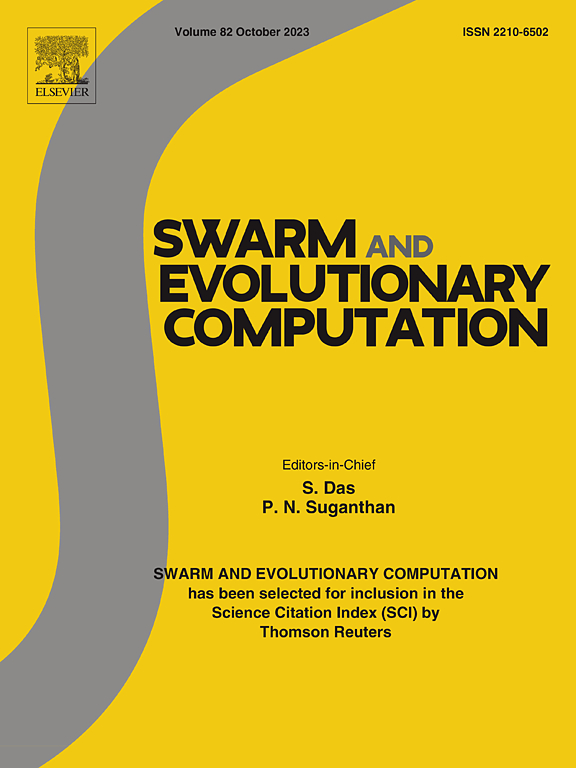Surrogate-Assisted Differential Evolution Light Gradient Boosting Machine for Mangrove Aboveground Biomass inversion
IF 8.5
1区 计算机科学
Q1 COMPUTER SCIENCE, ARTIFICIAL INTELLIGENCE
引用次数: 0
Abstract
Mangrove Aboveground Biomass (AGB) inversion holds considerable importance in safeguarding and rehabilitating blue carbon ecosystems, as well as their ability to adapt to climate change. In recent years, machine learning models based on heuristic algorithms for solving mangrove AGB inversion problems have gained wildly attention. However, these hybrid models are facing challenges, including expensive computation costs and low convergence speeds. Thus, an efficient Surrogate-Assisted Differential Evolution Light Gradient Boosting Machine algorithm (SADE-LGBM) is proposed to estimate mangrove AGB in the Maowei Sea, Beibu Gulf of China. This algorithm mainly contains: (i) Introducing a radial basis function surrogate model to predict the virtual fitness and identify promising solutions. (ii) An updating population strategy is proposed to update promising solutions to population efficiently. (iii) DE algorithm and LGBM model are combined to address hyperparameter optimization and feature selection simultaneously. To evaluate the performance of SADE-LGBM, we used a dataset consisting of 227 quadrat data collected from field surveys and compared SADE-LGBM with fourteen other algorithms. The experimental results illustrate that SADE-LGBM achieves the best metrics of = 0.8351, RMSE 220.4698, with the predicted range of mangrove AGB being 3.2765–207.5331 Mg/ha. The SADE-LGBM algorithm demonstrates its potential as a reliable algorithm for estimating large-scale mangrove AGB.
红树林地上生物量反演的代理辅助差分进化光梯度增强机
红树林地上生物量(AGB)反演对于保护和恢复蓝碳生态系统及其适应气候变化的能力具有相当重要的意义。近年来,基于启发式算法的机器学习模型求解红树林AGB反演问题得到了广泛关注。然而,这些混合模型面临着计算成本昂贵和收敛速度低等挑战。为此,提出了一种高效的代理辅助差分进化光梯度增强机算法(SADE-LGBM),用于估算中国北部湾茂尾海红树林的AGB。该算法主要包括:(1)引入径向基函数代理模型来预测虚拟适应度并识别有希望的解。提出了一项人口更新战略,以便有效地更新有希望的人口解决办法。(iii)结合DE算法和LGBM模型,同时解决超参数优化和特征选择问题。为了评估SADE-LGBM算法的性能,我们使用了由227个野外调查样方数据组成的数据集,并将SADE-LGBM算法与其他14种算法进行了比较。试验结果表明,SADE-LGBM在R2 = 0.8351, RMSE = 220.4698的条件下达到最佳指标,红树林AGB预测范围为3.2765 ~ 207.5331 Mg/ha。SADE-LGBM算法证明了其作为大规模红树林AGB估计可靠算法的潜力。
本文章由计算机程序翻译,如有差异,请以英文原文为准。
求助全文
约1分钟内获得全文
求助全文
来源期刊

Swarm and Evolutionary Computation
COMPUTER SCIENCE, ARTIFICIAL INTELLIGENCEC-COMPUTER SCIENCE, THEORY & METHODS
CiteScore
16.00
自引率
12.00%
发文量
169
期刊介绍:
Swarm and Evolutionary Computation is a pioneering peer-reviewed journal focused on the latest research and advancements in nature-inspired intelligent computation using swarm and evolutionary algorithms. It covers theoretical, experimental, and practical aspects of these paradigms and their hybrids, promoting interdisciplinary research. The journal prioritizes the publication of high-quality, original articles that push the boundaries of evolutionary computation and swarm intelligence. Additionally, it welcomes survey papers on current topics and novel applications. Topics of interest include but are not limited to: Genetic Algorithms, and Genetic Programming, Evolution Strategies, and Evolutionary Programming, Differential Evolution, Artificial Immune Systems, Particle Swarms, Ant Colony, Bacterial Foraging, Artificial Bees, Fireflies Algorithm, Harmony Search, Artificial Life, Digital Organisms, Estimation of Distribution Algorithms, Stochastic Diffusion Search, Quantum Computing, Nano Computing, Membrane Computing, Human-centric Computing, Hybridization of Algorithms, Memetic Computing, Autonomic Computing, Self-organizing systems, Combinatorial, Discrete, Binary, Constrained, Multi-objective, Multi-modal, Dynamic, and Large-scale Optimization.
 求助内容:
求助内容: 应助结果提醒方式:
应助结果提醒方式:


